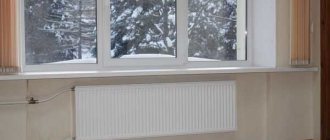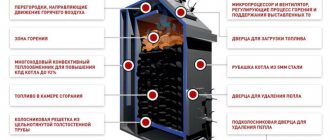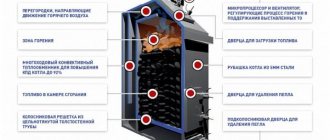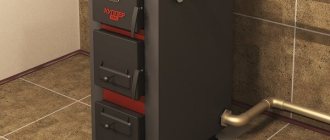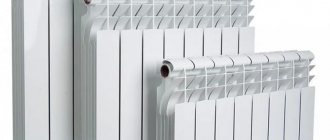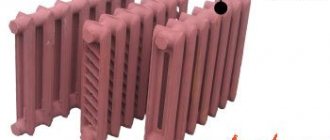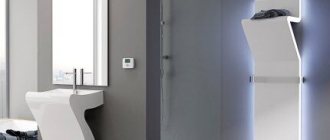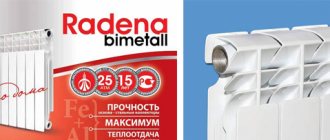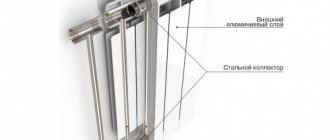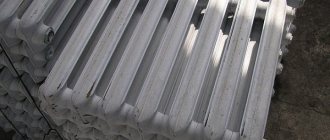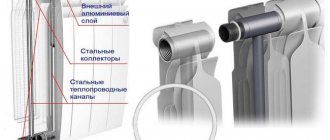Thin and flat heating radiators are not only a space saver. Single-panel devices that are not equipped with convection fins emit heat to a greater extent by radiation rather than by convection, and therefore dry out the air to a much lesser extent and transfer dust masses. Such panels are great for children's rooms, kindergartens, schools, and for owners with an allergic reaction to dust.
The thickness of radiators classified as flat is from 46 to 80 mm; they can be used in conjunction with a narrow window sill, do not require the installation of screens and look harmonious in almost any interior. In addition, they collect less dust and are less traumatic. However, the price to pay for comfort is much lower heat transfer and efficiency, susceptibility to corrosion and vulnerability to water hammer.
Manufacturers of flat panel heating batteries
The domestic market mainly presents foreign products - products from Kermi, Zehnder and Buderus.
Kermi
Flat models are offered here in two variations - with a smooth (Plan series) or grooved (Profil series) front surface, painted in two layers using a cataphoretic method. The side and top grilles can be removed to clean the products from dust. German models are available in the following varieties:
- valve modifications ThermX2. Depending on the power, different types of control valves are introduced;
- ThermX2 Kompakt small flat batteries are universal, they are mainly used in low temperature conditions;
- The Kompakt Hygiene hygiene line has a double varnish coating; it is common in hospitals, as its protective layer and simple design allow the use of disinfectant solutions.
The products are sold in the high price segment and exhibit effective heat transfer.
Zehnder
The manufacturer from Germany, in addition to classic variations, offers lines with non-standard sizes, shapes, and raw materials. Models with printed mirrors, wood and stone front panels, and paintings are common. Vertical and horizontal devices with angular and radius designs are offered.
The Plano series has a discreet design; convective lamellas are built into the batteries. Nova Mirror - ultra-fashionable flat products with shallow depth and a built-in mirror, optimal for narrow spaces.
Buderus
One of the concern's specializations is the production of flat steel radiators with bottom (Logatrend VK-Profil series) and side connections (Logatrend K-Profil). The models attract with high efficiency and unsurpassed quality of welds. The package includes valves designed for 1- and 2-pipe systems. Manufacturer's warranty – from 5 years.
If we compare the price ranges of the products of the three companies, Buderus flat radiators are the most affordable, while the upper limit is observed in the Plano series of the Zehnder brand.
The huge variety of heating devices that are present on the modern heating equipment market often confuses consumers. After all, the question of which is better is tormented precisely when the eyes run wide. This article will discuss heating radiators - “flat”. Why is this topic so interesting nowadays? Judge for yourself.
- Firstly, the flat design of the heating device increases the free space in the room. Accordingly, it becomes possible to install a window sill of smaller width.
- Secondly, it reduces the dust collection plane.
- Thirdly, it is an unusual and attractive appearance.
But here the question arises: what about heat transfer? It is no secret that this indicator largely depends on the size of the heating battery. That’s right, the heat transfer rate decreases, but it’s not for nothing that manufacturers produce these devices, which means there is some kind of trick that maintains the radiator power at the required size. We will deal with all these questions here.
Criterias of choice
Flat steel heating radiators are not installed in systems with natural coolant circulation, since a large amount of working fluid is needed here. Such batteries perform well in forced circulation circuits, but here it is necessary to correctly calculate the volume of the expansion tank and the performance of the circulation pump.
When choosing a model, it is necessary to take into account the height and thermal power. Low radiators are relevant for the characteristic height of the window sill (when it is not possible to install higher equipment). The lower the heating device, the more evenly the heat is distributed, creating a dense curtain.
Single-pipe wiring allows you to reduce installation costs, but here it is necessary to equip a bypass line. The shut-off valve will become a barrier to the coolant; it is necessary to ensure rational output of the device. With a single-pipe scheme, the most advantageous is a diagonal connection, when the coolant is supplied from the top left, and the outlet is organized from the bottom right.
The width of the radiator is selected so that it covers 50-75% of the same parameter of the window opening. Narrow models are not able to create a dense thermal curtain.
Types of connecting a heated floor to a heating system
Combined heating with radiators plus underfloor heating may be the only possible way to achieve comfortable indoor conditions. But for a number of reasons, it is impossible to connect a warm water floor with a simple “tie-in” into the riser or heating pipes, thus ensuring the supply of hot water and its return to the system (return).
The main ones are:
- independent circulation of water in thin and long pipes is impossible, which means that a pump is needed to connect to the heating;
- to match the pressure in the system, a pressure smoothing device is needed to prevent the effect of water hammer;
- it is necessary to remove air from the system;
- water filtration, which is especially important in central heating systems, implies the presence of dirt traps;
- the presence of a mixer is due to the need to mix water from the supply and return in certain proportions to achieve the required temperature in the heated floor circuit (lowering the water temperature relative to the heating system);
- devices for regulation and accounting (for housing and communal services) are objectively necessary.
Due to these factors, the scheme for connecting a heated floor to a heating system becomes significantly more complicated.
Types (diagrams) of connecting water heated floors in the case of autonomous home heating or upon obtaining permission from housing and communal services, which involve inserting directly into the system pipes, are presented in the figure.
Connection diagram of a water heated floor to a heating system
The simplest, and therefore inexpensive, scheme for connecting a heated floor to boiler “a” works using a two-way tap connected to a thermostat. The heat is regulated by decreasing or increasing the flow using control valves (3 and 4). Bypass valve 8 serves to equalize the pressure.
Scheme “b” is in principle similar to the first, with the only exception that the collectors are connected directly by a jumper 8 together with a valve that shuts off the supply when the pressure exceeds the permissible value.
Circuit “c” combines high reliability and simplicity. Here, a three-way valve (11) is installed on the return line, which redirects the cooled water to the supply section.
More advanced than the previous one, circuit “d” is distinguished by more sensitive temperature control. This is explained by the presence of a three-way mixer (9) on the supply pipe, which mixes the water until it enters the circulation pump (1).
There is no limit to perfection. The validity of the statement is confirmed by diagram “d”. It uses a four-way valve mixer, which can be controlled manually and using a servo drive that responds to signals coming from the thermostat unit.
Diagram “e” describes the optimal connection of a heated floor in an apartment to the central heating system through a heat exchanger (14). This assumes that you have the appropriate permit to perform this procedure, as well as an air vent, pressure gauge, overpressure valve and expansion tank (13). These elements make up the safety group (12) when connecting a heated floor from a battery.
The assembled pumping and mixing unit, which ensures the inclusion and control of a warm water floor, should look something like the one shown in the figure:
Pumping and mixing unit
Installation
A flat radiator is used for heating systems that have forced circulation of a coolant, that is, where circulation pumps are used.
The heating system using a flat battery is a closed structure and includes a membrane expansion tank. It looks something like this: the coolant, under the influence of the pump, flows through a direct pipeline, passes through the valve and then reaches the heat consumer, then passing through the air vent, it goes through the return pipeline to the membrane expansion tank. And from there the process repeats again.
Scheme of a closed heating system with flat radiators
If the coin cell battery installation uses an open system, the battery life will be significantly shorter. There is often no need to drain the water. Newly poured liquid always contains a high oxygen content, which will lead to corrosion on the radiator. It is not recommended to install thin devices in rooms with high air humidity, for example, in the bathroom. If all requirements and recommendations are followed, the risk of corrosion is minimal.
It is possible to install flat radiators with your own hands one after another, in this case the heat output will decrease by forty percent per meter, since the heat transfer through radiation after the second row will decrease. If they are installed in rows and equipped with plates on top, the result is a structure that looks like one device.
A flat battery is a closed, flat-type device through which a coolant moves.
When the battery device is used for a water heating system with plastic or metal pipes, an anti-diffusion barrier must be installed. It will protect against exposure to oxygen masses.
Before purchasing flat batteries, check the specifications of the flat battery device to see if they are suitable for your building. For example, when a building uses a gas boiler with a safety valve, the liquid pressure should be a maximum of 3.0 bar.
Pay attention to the temperature of the water in the pipes. The one who decides to change the radiators, throw out the outdated ones and install new ones argues incorrectly.
Before purchasing new radiators for heating, you need to make accurate calculations, take into account the characteristics of the building, the design of the installed or existing system, the technical characteristics of the device, and entrust the installation work to specialists
The one who decides to change the radiators, throw out the outdated ones and install new ones argues incorrectly. Before purchasing new radiators for heating, you need to make accurate calculations, take into account the characteristics of the building, the design of the installed or existing system, the technical characteristics of the device, and entrust the installation work to specialists.
Aluminum
The lowest aluminum radiators have a height of 245 mm. The Sira campaign has such models: Alux 80 and Alux 100, Rovall 80 and Rovall 100, Swing. They have a good heat output for such miniature products - 89-97 W. Global has a low radiator - model Gl-200/80/D. This model is cast, with a working pressure of 16 bar.
The lowest radiator at Global Gl-200/80/D has a height of 200 mm
There are aluminum radiators with an interaxal distance of 200 mm from the Russian manufacturer, Rifar, Rifar Base 200 and Rifar Forza 200. Moreover, their back wall is solid. You can safely place them with your back to the window and not worry about the appearance from the street.
But these are the smallest radiators. There is a large selection of models, the height of which will not be higher than 45 cm. Every company has such sizes, in almost every line. A center distance of 300 mm, 350 mm or 400 mm also fits into the low category.
Advantages, disadvantages
Any line has low batteries, with an axial distance of 300 or 350 mm
Advantages of aluminum radiators: lightweight, have high heat transfer, small capacity (little water can be placed), and quickly respond to temperature changes.
The most important disadvantage is the chemical reactivity of aluminum and its softness. For normal and long-term operation, a high-quality coolant is required: Ph 7-8, operating pressure - from 5-6 Bar for extrusion models, to 10-12 for cast ones. It is imperative that the coolant contains a small amount of oxygen and suspended matter. Oxygen promotes the oxidation and destruction of aluminum, and suspensions wear down the metal.
But each manufacturer has its own requirements. For example, Chinese aluminum Radena radiators operate at 16 Bar pressure and coolant with Ph 6.5-9. And Sira extrusion models have a working pressure of 16 Bar and a warranty period of 25 years. There are probably other aluminum radiators whose characteristics go far beyond the average: and there are too many manufacturers and models.
When choosing, do not forget about all these technical subtleties: only if the operating conditions coincide with the manufacturers’ recommendations, the heating will work for a long time and without failures.
Application area
Scope of application: in individual heating there are practically no restrictions, it is only worth paying attention to the temperature of the coolant, especially if the system has a coal or wood boiler. It is risky to install them in apartments
Unless they are very reliable and proven, and only if the coolant in the system meets the manufacturer’s requirements.
Read about the choice of radiators for an apartment and a house in the article “Aluminum batteries: types, selection, connection”
Advantages and disadvantages
Flat radiators have the following advantages:
- modern design, attractive performance. The equipment can complement most interior designs; if you want to disguise the device, you can use a special decorative screen;
- the devices do not require specific care; it is enough to wipe them with a damp cloth from time to time;
- radiators are supplied in such a configuration that there is no need for additional expenses;
- technical characteristics help save coolant;
- the compact device can be hidden in a niche or opening;
- possibility of DIY installation;
- The batteries heat the room efficiently.
Flaws:
- the need for strict compliance with the operating conditions recommended by the manufacturer, the vulnerability of steel models to corrosion;
- instability to water hammer. To ensure safe use, you need to install a pressure reducer or its equivalent into the system.
Another significant disadvantage is the relative fragility of the equipment, so it is important to organize careful transportation of products
How to make a flat screen for a battery out of wood, work sequence
So, in order to make a battery screen with your own hands from wood, you will need to purchase:
- Bar with a cross section of 20x20mm. Its quantity should correspond to the perimeter of the niche.
- Rail. You can choose its sizes at your discretion. From experience I will say that the best option would be a thin strip 20mm wide.
- 50mm wide rail for screen cashing.
- Self-tapping screws for connecting bars.
- Small nails for fastening the slats.
The tools you will need are a hacksaw, hammer, screwdriver, tape measure, drill or screwdriver.
How to make a screen for a battery with your own hands photo
Let's start manufacturing. We measure the length of the niche and cut off two bars accordingly. We do the same with the height of the niche, only we additionally reduce the length of the cut bars by two of its thickness. In principle, it is better to reduce both the length and height of the finished frame by at least 5mm. This is necessary so that small deviations in the geometry of the niche do not cause problems during installation. We connect the resulting four bars together into a rectangular frame using self-tapping screws. To prevent the beam from cracking when screwing in the screws, you need to drill a hole for them in advance - the diameter of the drill should be one third or half less than the diameter of the self-tapping screws used.
At the next stage, we cover the resulting frame with slats. Here you need to check one point - the diagonal of the future screen. If it turns out skewed, then inserting it into a niche will be problematic, and its appearance will be, to put it mildly, useless. Once the frame is trimmed and painted or varnished, you can begin installing the screen.
Screen for battery photo
Installing such a screen on a battery is very simple. On the side slopes of the niche, from its outer corner, a size equal to the thickness of the screen is deposited. You need two marks at the top and bottom of the slope. In these places, a wooden block is installed using a hammer drill and dowels, to which the screen is screwed with self-tapping screws. If the need arises to get to the battery, it will be enough to unscrew four screws.
This is how flat screens for radiators are made. All that remains is to install the decorative trim and hide the places where the screen is attached and its contact with the slopes. Before installation, the trim will need to be trimmed and painted. They are fastened with nails, the head of which is first removed.
Author of the article Alexander Kulikov
Classification
When classifying heating batteries, numbers are used, the first of which indicates the number of lamellar sheets, the second - the number of ribs:
- The figure shows that there is only one plate and a complete absence of ribs.
- One lamellar sheet complemented by a rib design.
- Two lamellar sheets, one equipped with convection fins.
- Three lamellar leaves, all connected to ribs.
Classification of flat radiators
An additional part of flat batteries is the upper grille, which has side housings on both sides. As a rule, it is snow-white. The battery packaging kit is supplemented with fastening parts. Wall partitions made from different materials require different means of fastening. If the packaging kit is not supplemented with the fastening elements that are needed in a particular case, you will have to purchase others yourself.
Flat radiators are equipped with four connection pipes. This makes it possible to connect the device to the entire heating system from any side. As a rule, they are connected directly to the heating riser or specially designed fittings are used.
There are flat steel radiators equipped with a thermostatic valve. It regulates the fluid inside the product. It is connected on the right side; to connect on the left, you need to make a special order.
Some factories that manufacture flat batteries and heating radiators create horizontal models that connect to the wall surface in the middle. The presence of a valve insert is not necessary. To make a connection from below, hiding the heating pipes in the floor, the packaging set must be integrated. There are connecting parts that are hidden in the walls.
When choosing a method for connecting radiators, take into account the price cost of the product, the design of the room, building, type or type of heating in general. Standard heating systems require side connections; if pipes run under the floor, use bottom connections.
Design
Flat heating radiators consist of two plates, made by stamping and welded together. Between such plates there is a space (channel) - this is where the coolant will circulate. To connect the batteries to the heating system, there are special pipes. Using certain types of connections, you can form flat, thin heating radiators from two or three plates.
That is why the power of a device that has fins will be almost 60% greater. But there will also be more dust on such products, so they are placed in rooms that have high sanitary requirements.
Sectional view of a panel heating radiator
In order to correctly classify plate heating radiators, special designations with numbers are used, which are the same for most manufacturers of such products. The first number is the number of plates, the second is the number of plates that have convection fins:
- 10 – one plate without convection fins.
- 11 – one plate with convection ribs.
- 21 – two plates, one of them has convection ribs.
- 33 – three plates and each has convection ribs.
The thin heating radiators, which are presented above, are also additionally equipped with side casings with grilles on top. They are usually white in color.
White flat radiatorIf we talk about the standard delivery set, it includes a set of fastening elements for brick walls. If your walls are different, you will have to buy separately all the fasteners that are required to install narrow radiators.
Typically, narrow heating radiators are connected either directly to the heating system riser, or using special fittings.
In addition, there are also batteries that immediately have a kit for connecting to a thermostatic valve. With the help of such an insert with a thermostatic head, the speed of water in the product is controlled. Such a kit is usually connected on the right side, however, upon special order, the manufacturer can create a battery with a kit for installation on the left side.
Flat vertical radiator with connection in the middle
Some manufacturers have in their assortment such narrow horizontal heating radiators that can be connected to the heating system in the middle - with or without a valve insert. If the heating radiators have an integrated kit, then they will be ready to be connected to the heating system from below, when the pipes are hidden under the floor. Special connecting elements with pipes that are hidden in the wall are also used. Such pipelines will not spoil the appearance of the room that is heated.
For a standard type heating system, when the pipes go on or in the wall, plate heating radiators with a side connection are used. For a system with a pipeline in the floor - connection from below.
Features of operation
When using technology, you must adhere to the following restrictions:
- the coolant temperature should not exceed 110-120°C;
- the recommended operating pressure, depending on the model, varies between 4.5-10 MPa;
- the small volume of working fluid used implies forced circulation;
- the maximum permissible acidity of water is 8.5 pH;
- It is not recommended to install steel products in damp areas.
Flat batteries are not intended for installation in apartments connected to central heating. Experts do not advise frequently replacing the coolant to prevent oxygen from entering the radiator cavities. The optimal conditions for using the product are a closed system with a circulation pump and a membrane-type expansion tank (the latter protects the equipment from water hammer).
Installation of a forced convection heating duct in the floor for water heating
If you install a heating boiler with forced convection in the floor, in addition to the steps listed above, you need to connect a ventilation system.
Fans should be located closer to the window or on both sides of the heat exchanger.
Depending on the length of the heating duct, there may be several fans. All of them are combined into a common scheme. The fans are powered from alternating current 220 volts or through a step-down transformer, which is included in the radiator kit.
There are no difficulties in connecting, you just need to supply power to the fans in advance.
Obotoplenii.ru
Type classification
The main criterion for dividing into types is the standard size, it is indicated on the product labeling:
- type 10. Standard panel models that do not have additional options, they are simple, have a minimum depth of 46 mm;
- type 11. Slightly thicker than the previous version due to the fact that convection ribs were added to one side. Here the depth is 59 mm;
- type 12. A complex product formed by two panels and fins between them, the thickness of the device is 64 mm;
- type 22. Two panels equipped with two fin systems, depth 102 mm;
- type 33. The thickest panels are 157 mm, these are three panels with three parts of fins.
Sectional and panel oil heaters can be floor-mounted or wall-mounted; here mineral oil is used as a coolant. The liquid cools down longer than water, which enhances the operational advantages of the model. Flat oil-type radiators have the following advantages:
- simple installation that you can do yourself;
- low dead weight, expanding the possibilities of application on any walls;
- loyal prices and a wide range of technical solutions and dimensions;
- low-temperature mode of use, eliminating burns;
- the device does not dry out the air and ensures a healthy microclimate;
- moderate energy consumption.
Wall-mounted flat convectors have a heating element inside; it directs thermal energy to metal plates. Heated air enters the room through the slots provided in the upper segment of the casing. The principle of convection of air flows ensures rapid and uniform heating of the room. Such universal devices are often used in country cottages with year-round use.
The battery connection can be side or bottom: the letter “K” on the marking is for the first option, “Kv” for the second.
What are flat heating radiators
We need to start talking about flat radiators with their depth size. There is no exact indicator that would indicate the thinness of the device. This is mainly determined by eye. For example, you can take a cast iron radiator as a standard - this is a common design. Anything less than half its depth can be classified as flat heating radiators.
If we review all existing models, then only steel panel batteries are suitable for this standard. We will consider them. Why is it that panel structures have a small thickness? It's all about the technology of their manufacture.
These are devices made from stamped steel sheets. The form is based on a single sheet with a fairly large recessed area. That is, it is not a sectional design, but a flat one covering the entire area of the heating device itself. This is precisely what increases thermal output. But at the same time, the depth of each panel is not very large, and accordingly the volume of coolant used in the heating system in the flattest radiator will be small. This ratio has an undoubted advantage - low fuel consumption for heating the coolant. That is, these two quantities are in direct proportion to each other.
Flat battery
The producers went further. They did not focus on devices with a purely panel form, because, as mentioned above, this form has reduced power. To increase this indicator, additions were made to the structure itself in the form of a fin system, the so-called convection fins. They are welded over the entire area of the battery using spot welding. The basic shape of the ribs is trapezoidal.
Minimalism
Minimalism will be a good basis for another modern design in the living room combined with the kitchen. At the same time, the rooms are kept in perfect order and unnecessary things are hidden. To maintain minimalism in the kitchen, you will need cabinets and drawers in which you can put dishes and other kitchen utensils.

